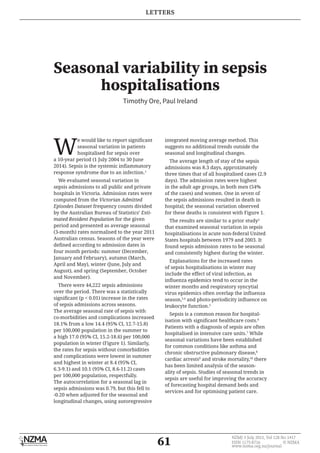More Related Content
Similar to ++1417++Ore
CNS Iinfection dengue, Teaching Slides, Dr M D Mohire, Kolhapur, Maharashtra,...CNS Iinfection dengue, Teaching Slides, Dr M D Mohire, Kolhapur, Maharashtra,...Mahavir Mohire
Similar to ++1417++Ore (20)
++1417++Ore
- 1. 61
NZMJ 3 July 2015, Vol 128 No 1417
ISSN 1175-8716 © NZMA
www.nzma.org.nz/journal
LETTERS
Seasonal variability in sepsis
hospitalisations
Timothy Ore, Paul Ireland
W
e would like to report significant
seasonal variation in patients
hospitalised for sepsis over
a 10-year period (1 July 2004 to 30 June
2014). Sepsis is the systemic inflammatory
response syndrome due to an infection.1
We evaluated seasonal variation in
sepsis admissions to all public and private
hospitals in Victoria. Admission rates were
computed from the Victorian Admitted
Episodes Dataset frequency counts divided
by the Australian Bureau of Statistics’ Esti-
mated Resident Population for the given
period and presented as average seasonal
(3-month) rates normalised to the year 2011
Australian census. Seasons of the year were
defined according to admission dates in
four month periods: summer (December,
January and February), autumn (March,
April and May), winter (June, July and
August), and spring (September, October
and November).
There were 44,222 sepsis admissions
over the period. There was a statistically
significant (p < 0.01) increase in the rates
of sepsis admissions across seasons.
The average seasonal rate of sepsis with
co-morbidities and complications increased
18.1% from a low 14.4 (95% CI, 12.7-15.8)
per 100,000 population in the summer to
a high 17.0 (95% CI, 15.2-18.6) per 100,000
population in winter (Figure 1). Similarly,
the rates for sepsis without comorbidities
and complications were lowest in summer
and highest in winter at 8.4 (95% CI,
6.3-9.1) and 10.1 (95% CI, 8.6-11.2) cases
per 100,000 population, respectfully.
The autocorrelation for a seasonal lag in
sepsis admissions was 0.79, but this fell to
-0.20 when adjusted for the seasonal and
longitudinal changes, using autoregressive
integrated moving average method. This
suggests no additional trends outside the
seasonal and longitudinal changes.
The average length of stay of the sepsis
admissions was 8.3 days, approximately
three times that of all hospitalised cases (2.9
days). The admission rates were highest
in the adult age groups, in both men (54%
of the cases) and women. One in seven of
the sepsis admissions resulted in death in
hospital; the seasonal variation observed
for these deaths is consistent with Figure 1.
The results are similar to a prior study2
that examined seasonal variation in sepsis
hospitalisations in acute non-federal United
States hospitals between 1979 and 2003. It
found sepsis admission rates to be seasonal
and consistently highest during the winter.
Explanations for the increased rates
of sepsis hospitalisations in winter may
include the effect of viral infection, as
influenza epidemics tend to occur in the
winter months and respiratory syncytial
virus epidemics often overlap the influenza
season,3,4
and photo-periodicity influence on
leukocyte function.5
Sepsis is a common reason for hospital-
isation with significant healthcare costs.6
Patients with a diagnosis of sepsis are often
hospitalised in intensive care units.7
While
seasonal variations have been established
for common conditions like asthma and
chronic obstructive pulmonary disease,8
cardiac arrests9
and stroke mortality,10
there
has been limited analysis of the season-
ality of sepsis. Studies of seasonal trends in
sepsis are useful for improving the accuracy
of forecasting hospital demand beds and
services and for optimising patient care.
- 2. 62
NZMJ 3 July 2015, Vol 128 No 1417
ISSN 1175-8716 © NZMA
www.nzma.org.nz/journal
LETTERS
1. Bone RC, Balk RA, Cerra
FB et al. Definitions of
sepsis and organ failure
and guidelines for the use
of innovative therapies
in sepsis. The ACCP/SCCM
Consensus Conference
Committee. American
College of Chest Physicians/
Society of Critical Care
Medicine. Chest 1992;
101: 1644-1655.
2. Danai PA, Sinha S, Moss M
et al. Seasonal variation
in the epidemiology of
sepsis. Critical Care Med
2007; 35 (2): 410-415.
3. Dowell SF. Seasonal
variation in host suscep-
tibility and cycles of
certain infectious diseases.
Emergency Infectious
Diseases 2001; 7:369-374.
4. Griffin MR, Coffey CS,
Neuzil KM et al. Winter
viruses: Influenza- and
respiratory syncytial
virus-related morbidity
in chronic lung disease.
Arch Intern Med 2002;
162:1229-1236.
5. Yellon SM, Kim K, Hadley
AR et al. Time course and
role of the pineal gland
in photoperiod control
of innate immune cell
functions in male Siberian
hamsters. J Neuroimmunol
2005; 161: 137-144.
6. Angus DC, van der Poll.
Severe sepsis and septic
shock. New Engl J Med
2013; 369 (9) :840-51.
7. Sundarajan V, MacIsaac CM,
Presnell JJ et al. Epidemi-
ology of sepsis in Victoria,
Australia. Critical Care
Med 2005; 33 (1): 71-80.
8. Osborne ML, Vollmer
WM, Buist AS. Periodicity
of asthma, emphysema,
and chronic bronchitis
in a northwest health
maintenance organisation.
Chest 1996; 110:1458-1462.
9. Peckova M, Fahrenbruch
CE, Cobb A et al. Weekly
and seasonal variation in
the incidence of cardiac
arrests. Am Heart J
1999; 137: 512-515.
10. Lanska DJ and Hoffmann
RG. Seasonal variation
in stroke mortality rates.
Neurology 1999; 52:984-990.
Author information:
Timothy Ore, Evidence and Evaluation Advisor, Innovation Hub and Health System
Improvement, Department of Health and Human Services; Paul Ireland, Manager Business
Development, Innovation Hub and Health System Improvement, Department of Health and
Human Services, 50 Lonsdale Street, Melbourne 3000, Australia
timothy.ore@health.vic.gov.au
URL:
www.nzma.org.nz/journal/read-the-journal/all-issues/2010-2019/2015/vol-128-no-1417/6584
REFERENCES:
Figure 1: Seasonal Rates of Sepsis Hospitalisations Per 100,000 Population, 2004–05 to 2013–14
